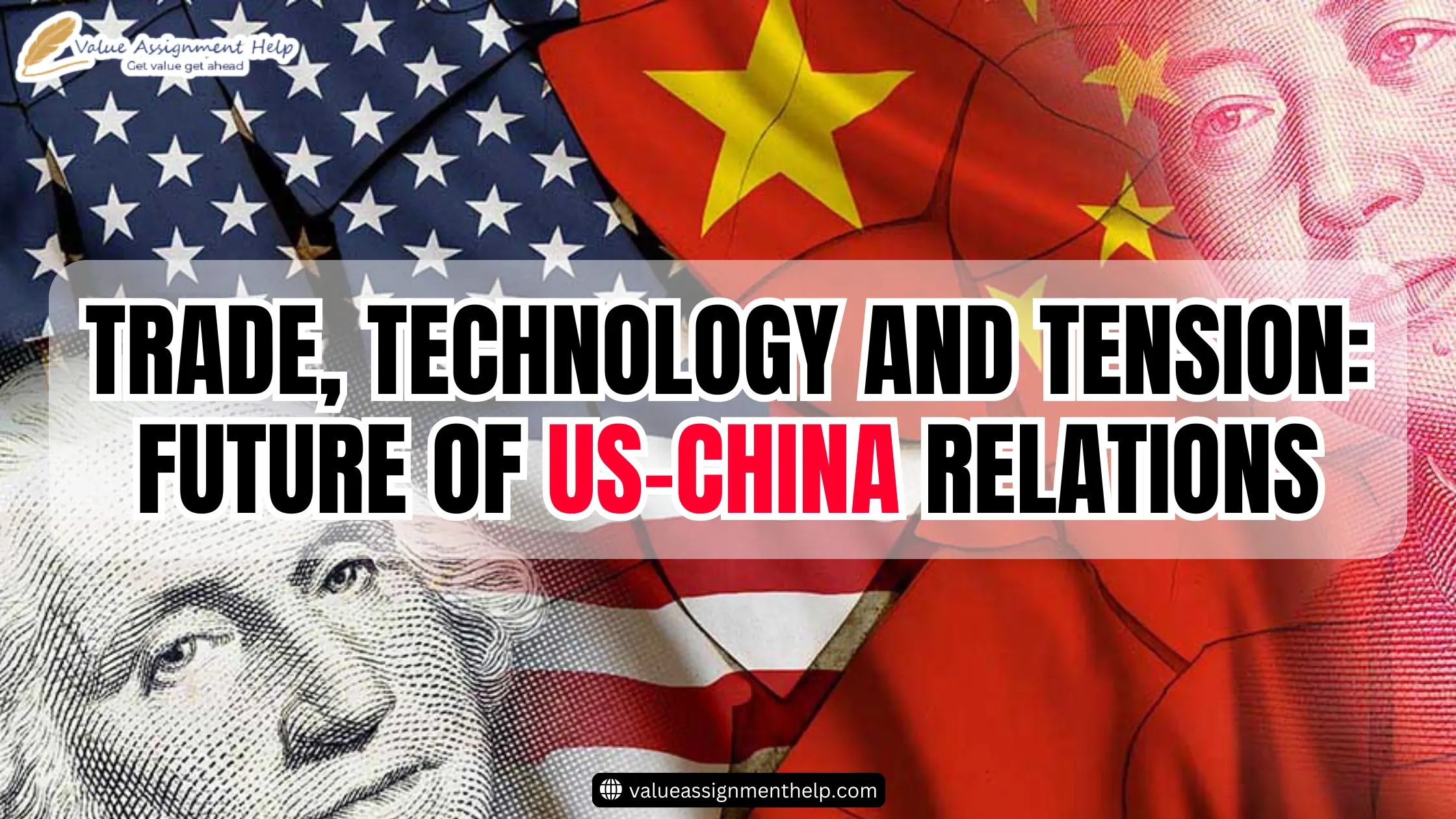Trade, Technology and Tension: Future of US-China Relations
The world's largest economies have had their differences over the years. Their multifaceted diplomatic decisions displayed their strategic competition with every nation. The global titan's trade, tariffs, market access, and geopolitical factors are the major issues stressing their political and military decisions.
The countries have also worked together to tackle global challenges like climate change, global health research, nuclear security and transnational crimes. However, the countries are still contesting over global power. The global powers need to promote political trust and collaboration for a productive future.
New challenges have been taking place in recent years for both countries. The States have pointed out that China works unlawfully and poses a risk to the U.S. military, economy and security as well. Similarly, China states U.S. trade policies, stifling technological advancements and interference in internal affairs with Taiwan have caused instability in relations.

Unfair Trade Practices and Trade War
The trade relations between the US and China are influenced by macroeconomic factors. The growing trade surplus in China and the deficit in trade imbalance for the US have sparked a debate on their causes (Gourinchas et al., 2024). The States have poked China for its unfair trade practices related to information transfers and intellectual property theft. China argues that the U.S. is hindering its economic rise and implementing tariffs and policies to distort trade relations.
It is to be noted that China and the United States are the top exporters to each other. This has provided China with a wider market to trade in and U.S. consumers with lower prices and profits for corporations. The market value of the imported good from China to U.S has increase to $400 Billion. (Siripurapu and Berman, 2024)
The U.S. accused China of using a state-owned enterprise and industrial policies to get a hold of the trade market which sides with U.S. companies to a disadvantage. With further issues of manipulating their currency to make exports cheaper and more affordable. It created a trade imbalance with unfair practices to manipulate the market flow.
Technology Competition
The tech war between China and the States is a matter of national security and economic boost. U.S. organizations have individually captured around 54% of profits generated by technologies globally. The US has acknowledged its competition and made advancements in semiconductors and clean energy innovations.
China has a hold of 9% of the global technological market but with a rapid advancement in Artificial Technology or AI, their economic growth is broad. Investments in the innovations domestically have controlled the innovations and removed any dependency on foreign advancements. (USCC, 2024)
China has been accused of leaks in Cyber espionage of U.S. companies with their hacking which has caused issues in national security and defense contracts. The accusation was related to China using the gathered information to fuel its advancements and accelerate its development in technologies.
Biotechnology is a new development area where both countries are pacing for lead. Though the States already hold the lead in the biomedical research and pharmaceutical sector, China also started investment in biotech startups for CRISPR technology to modify DNA and artificial organ development.
Human Rights Differences
The U.S. has always criticized China for their treatment of most debatable regions like Tibet, Xinjiang, and Hong Kong. States believe China has been repressing the political freedom of these nations. Following 2020, when national security law was imposed, the U.S. started to advocate for the protection of people in Hong Kong for their autonomous way of living. (US Department of States, 2023)
All the debated regions struggle to keep their work free from Chinese government influence. For Tibet, they want to preserve their individual identity while China is underdeveloped which can be improved with their better support and economic support. For Xinjiang, China claims their help interference will develop social stability and reduce the impact of their extreme religious terrorism.
China always asserted their decisions stating that these are internal issues of the country. Putting everything under false accusation China claims it will help to maintain security and stability in all the regions under question. With no human rights violations, the country points to the U.S. for Western interference and misleading from the truth.
Strategic Confrontations over the South China Sea
The South China Sea is the busiest route for trade shipping around the world. Dating back to the 1940s, China claims that the area of the South China Sea is under their territory as historical rights. Rich in natural resources like natural gas and oil, many countries like Vietnam, Malaysia, the Philippines, Taiwan, and Brunei have claimed their regions on the sea.
To gain control over the South China Sea, China has imposed a highly imposed military presence in the area which has raised alarms for the neighboring country Philippines for invasion. According to the United Nations Convention on the Law of the Sea (UNCLOS), China has violated the rights of the Philippines but China refuses to accept the decision stating historical rights cannot be overlooked and no international law will be accepted.
U.S. involvement started when they saw a breach in “freedom of navigation” and claimed no singular nation could claim the waterways. They paired with the Philippines to counterbalance the military actions and influences of China. America wanted a binding code of conduct that would bind the activities of the country in the area (Center for Preventive Action, 2024).
Biden stated in 2023 that, ‘The United States will defend the Philippines if the situation gets agitated. Any attack on the Philippines over the South China Sea matter will ensure that the U.S. gets involved to help the Philippines.
Self Determination Geo-political Issue between Taiwan, U.S. and China
The Republic of China (Mainland China) and the Republic of China (Taiwan) both separated their political systems during the Chinese Civil War. Though they maintained to be a part of the legitimate government of China (One-China policy), both countries maintained themselves as Sovereign states.
China has always insisted that Taiwan is a part of their territory. They believe that eventually the area will be reunited under the “one country, two systems” policy (Csanyi, 2024). Taiwan formally stated that they are independent and they are identified as Taiwanese individuals refusing to be accepted as Chinese. Beijing has put military pressure on Taiwan (Taipei).
U.S. involvement officially began when the Taiwan Relations Act was passed, which made sure relations between both countries. This also included the military help from the States to Taiwan to protect themselves in military exercises. The U.S. straightened Taiwan with a strong military presence in Indo-Pacific regions to reduce the effect of the Chinese military. This helped China call out this interference as poking into the internal affairs of the country.
President Xi Jinping of China made a statement about the situation claiming, ‘Two different countries might have different views on the same topic, the key is to handle the issue properly to manage it.’
Conclusion
The future of both superpowers depends upon their ability to manage their complex dynamics. With the hope of better cooperation and healthy competition coming years can benefit from the resources of both nations. Unfair trade and conflicting beliefs over diplomatic decisions can drive more tension. Resolving political conflicts is very important to make sure that the partnership is constructive.
Overall strategic confrontation must be dealt with sensitivity to maintain peace and stability globally. China and United States are superpowers which can shape the world for good. Their cooperation has the ability to foster great innovations whereas their conformations can lead to more disruption in economy and geopolitical instability. By shared global responsibility U.S. and China can pave the way for an advanced future which is the need of the hour.
Reference list
Center for Preventive Action (2024). Territorial Disputes in the South China Sea. [online] Global Conflict Tracker. Available at: https://www.cfr.org/global-conflict-tracker/conflict/territorial-disputes-south-china-sea.
Csanyi, P. (2024). Why China-Taiwan Relations Are So Tense? [online] Available at: https://taiwanfellowship.ncl.edu.tw/files/scholar_publish/2296-qskhdavdcvtasql.pdf.
Gourinchas, P.-O., Pazarbasioglu, C., Srinivasan, K. and Valdés, R. (2024). Trade Balances in China and the US Are Largely Driven by Domestic Macro Forces. [online] IMF. Available at: https://www.imf.org/en/Blogs/Articles/2024/09/12/trade-balances-in-china-and-the-us-are-largely-driven-by-domestic-macro-forces.
Siripurapu, A. and Berman, N. (2024). The Contentious US-China Trade Relationship. [online] Council on Foreign Relations. Available at: https://www.cfr.org/backgrounder/contentious-us-china-trade-relationship.
US Department of States (2023). U.S. Relations With Hong Kong - United States Department of State. [online] United States Department of State. Available at: https://www.state.gov/u-s-relations-with-hong-kong/.
USCC (2024). TECHNOLOGY AND CONSUMER PRODUCT OPPORTUNITIES AND RISKS. [online] United States–China Economic and Security Review Commission. Available at: https://www.uscc.gov/sites/default/files/2024-11/Chapter_3--U.S.-China_Competition_in_Emerging_Technologies.pdf.














No Comments